Before entering the gambling table, it is the "gambler's" first duty to understand the rules.
Written by: 237, MetaEra
The abnormal surge in Gas fees
In the early hours of July 29, 2023, the night was as calm as usual. But at this moment when one should have been peacefully asleep, the crypto world was filled with some unusual restlessness…
According to Nansen data, in the early hours of July 29, Gas fees on the Ethereum blockchain suddenly surged, with the median reaching as high as 360 gwei, causing the network to become unusually congested.
At the same time, a chat screenshot began circulating among WeChat groups.
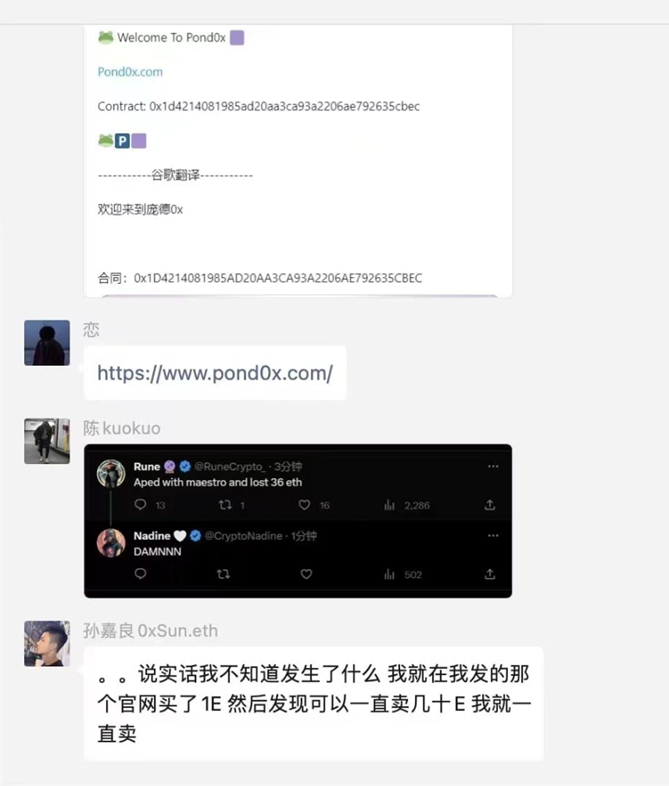
At first glance, this seems to be just an ordinary chat screenshot, but a statement by 0xSun stands out:
"To be honest, I don't know what happened. I just bought 1 ETH on the official website and found that I could sell dozens of ETH continuously, so I kept selling."
So, what exactly happened? What is the official website mentioned by 0xSun in the conversation? What does he mean by buying 1 ETH and selling dozens of ETH? And does all of this have some kind of connection to the crazy surge in Ethereum Gas fees?
Now, let's go back to the source of all this restlessness, which is the website mentioned in the above conversation: https://www.pond0x.com/
Pond0x: Scam or Social Experiment?
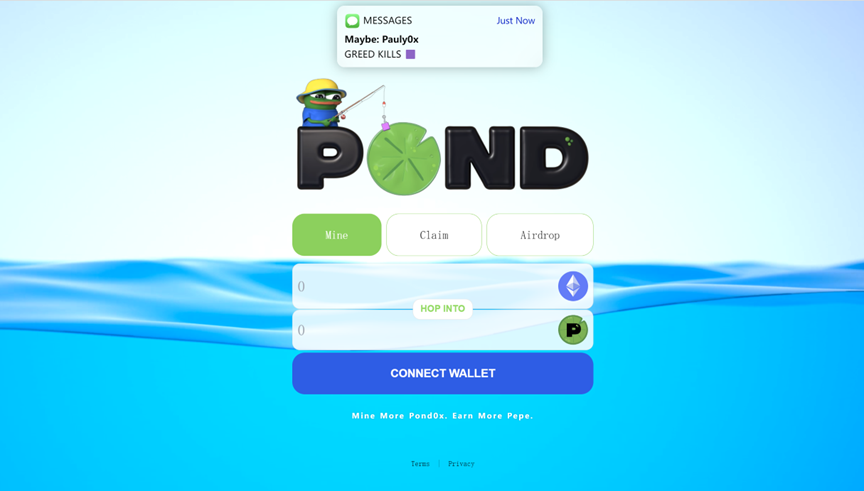
After opening the website mentioned by 0xSun, we will find that it is a project called Pond0x. Pond0x is a project launched by Pauly, the founder of the NFT market Not Larva Labs. In terms of the nature of the project, the author tends to define it as a Memecoin.
At 12:29 am on July 29, 2023, Pauly tweeted for the first time, revealing the website address and token contract address of Pond0x.
Welcome To Pond0x http://Pond0x.com• $PNDX Contract: 0x1d4214081985ad20aa3ca93a2206ae792635cbec

This tweet instantly attracted many keen-scented Memecoin players. This is also closely related to Pauly himself, and the story about him will be discussed separately later. For now, let's put it aside.
The release of Pond0x quickly caused a small wave of excitement in the Memecoin player community. Funds from various sources also began to pour into the Pond0x pool through the two channels mentioned in the tweet (the official website and the token contract address).
The story seems to be following the typical path of a Memecoin—creating hype, expanding the pool, continuous diffusion, and then early players cashing out, followed by later players taking over. But this bland gameplay is clearly not Pauly's style. As expected, Pond0x is not just a simple pool.
The first clue was discovered by a player named 0xSun, who is the protagonist of the chat screenshot mentioned above.
As a seasoned Memecoin player, in the early hours of July 29, 0xSun, as usual, opened Twitter to browse information in hopes of finding some potential opportunities. The latest update from Pauly, who had long been on his watchlist, quickly caught his attention. Without much thought, 0xSun sent 1 ETH to the Pond0x pool through the official website and received a certain amount of PNDX tokens. Then, while monitoring the token price, he noticed some clues—the cost of obtaining tokens from the official website was hundreds of times lower compared to Uniswap! So, he tentatively started selling the PNDX tokens he held on Uniswap. Finally, he was surprised to find that the tokens he obtained with 1 ETH were sold for a whopping 44.5 ETH. After completing this bewildering transaction, 0xSun quickly shared his amazing experience in a WeChat chat group, leading to the chat record mentioned above.

It turns out that the official website of Pond0x is not a real Swap; its essence is a PEPE LP Farm disguised as a Swap. Users who swap through the website actually inject their Ethereum as liquidity into the PEPE LP Farm. As a result, these users will receive a PID (representing their allocated ID) and a base, which will determine the user's share in the pool, i.e., the fixed exchange amount of PNDX tokens. This fact can also be discovered by clicking on the "HOP INTO" button on the official website.
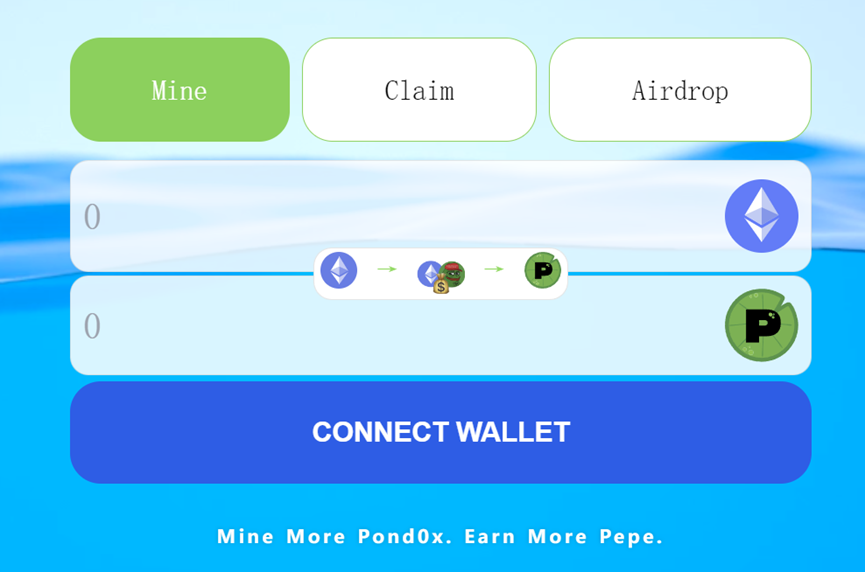
At the same time, from the on-chain data provided by the Ethereum browser, we can also see that the Method column shows "Mine Liquidity," not "Transfer."
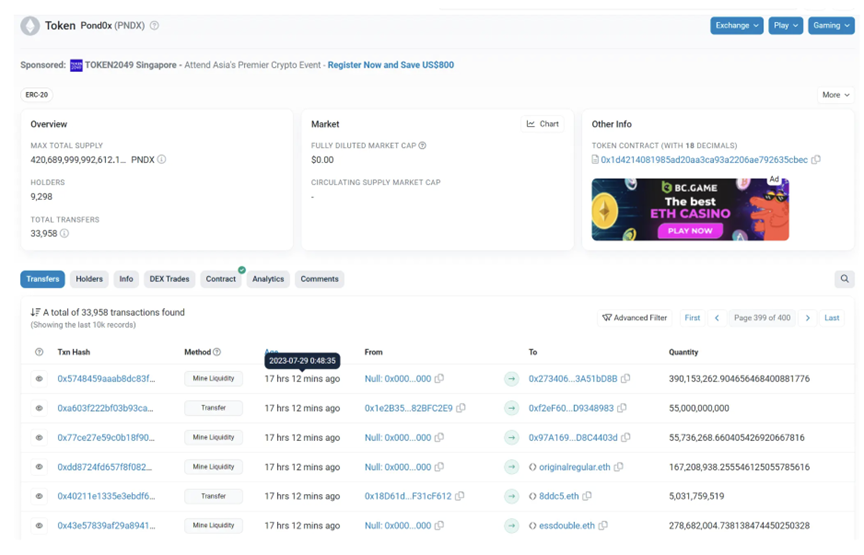
The token contract address provided by Pauly's tweet is the real token trading address, and its cost is hundreds of times higher than that of the official website. From this design, we can understand that Pauly may have initially intended to "sacrifice" some users as liquidity providers.
But then someone might ask, if all users obtain PNDX tokens through the official website, doesn't this design make no sense at all? Good question!
So, when a large number of users flocked to the official website, later users found that due to network congestion, they could no longer access it. At this point, users who were attracted by huge profits and had not understood the fundamental logic of this event seemed to have only one choice—rush to the contract. And this is exactly what Pauly had in mind—sacrificial offerings. When these users rushed to Uniswap and completed the swap, they would only be met with the endless selling pressure from the official website users (as well as their own astonishment).
Reviewing Pauly's logic in this operation, we can see that he truly understood the habits and psychology of Memecoin users.
First, Pauly released the news on Twitter to attract initial users, and made a distinction between the contract and the website (to see if users would understand the rules before entering the gambling table). Then, he distributed a large number of low-priced chips to users who were keen-scented, understood the rules, and were lucky (i.e., website users) to sell alongside him. Later users who rushed to Uniswap could only become contributors to liquidity. From this process, we can see that Pauly had long understood a principle: "The essence of an excellent project is not to make everyone earn money, but to make its core users earn money." At the same time, Pauly also understood that the main way Memecoin spreads in the community is through the contract address, not the website, plus the guaranteed website traffic limit, which allowed him to "excellently" accomplish the mission of making his core users earn money.
But the story doesn't end here.
Twitter user @YazanXBT tweeted at 12:57 am on July 29, 2023, claiming that there seems to be a vulnerability in Pond0x's contract code, and the Pond0x in their wallet has been transferred away in an unknown way.
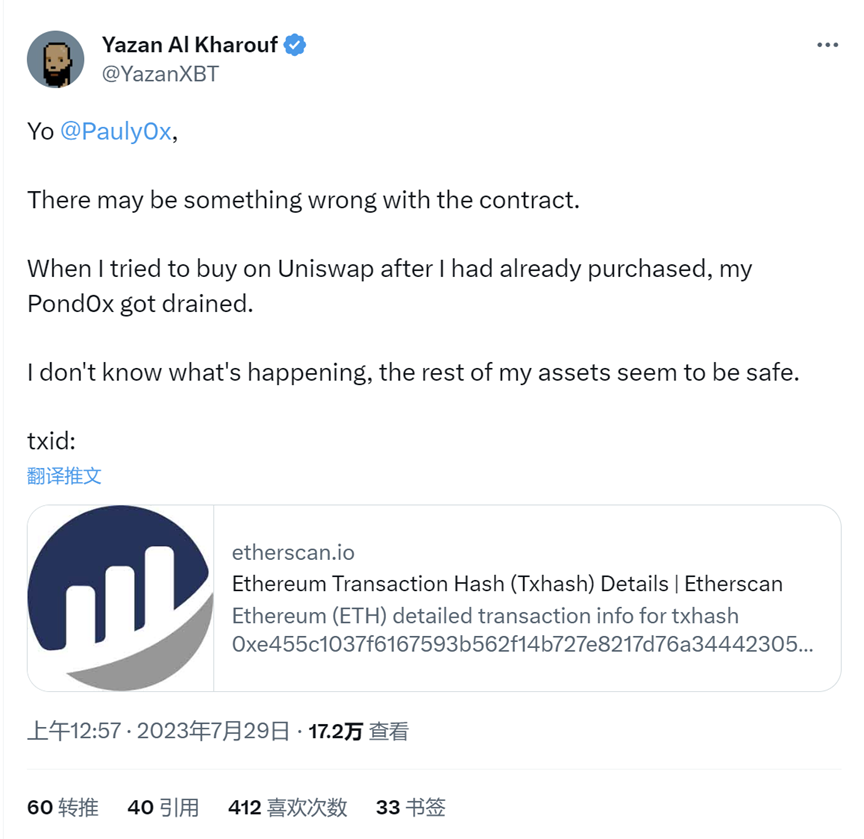
Subsequently, many users also reported encountering the same issue.
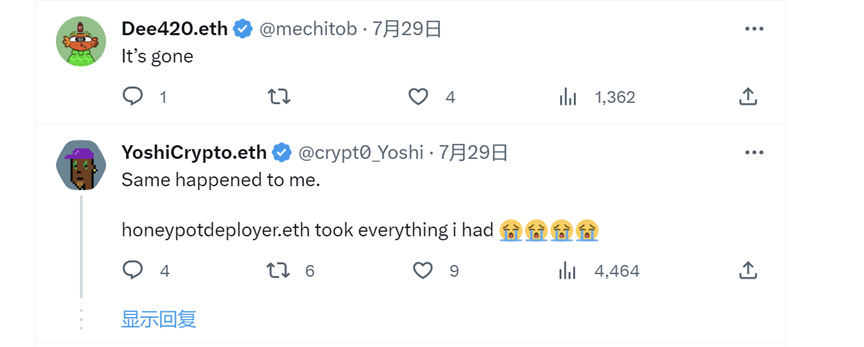
After professional verification, it was found that there is indeed a problem in Pond0x's contract code. The transfer function in the contract code allows anyone to transfer tokens from any address.

Here, the project team may have misunderstood the workings of Ethereum. The Gas operator in the EVM does not provide a non-deterministic Gas Cost, but rather provides the Gas Remaining up to that point. Therefore, this function allows attackers to control the calculation results by controlling the Gas provided, making it easy to transfer the balance of any holding address.
Once this news of the vulnerability spread, a large number of users began to frantically exploit the vulnerability, coupled with the melee in the Pond0x secondary market, causing the Gas fee on the Ethereum blockchain to surpass 400 gwei.
And Pauly, who triggered all of this, had already completed arbitrage of over 400 ETH and peacefully fallen into slumber.
"On-chain data shows that the two associated addresses realpond0xdev.eth & 0x36…40BC have profited from this event by at least 450 ETH."
Who exactly is Pauly?
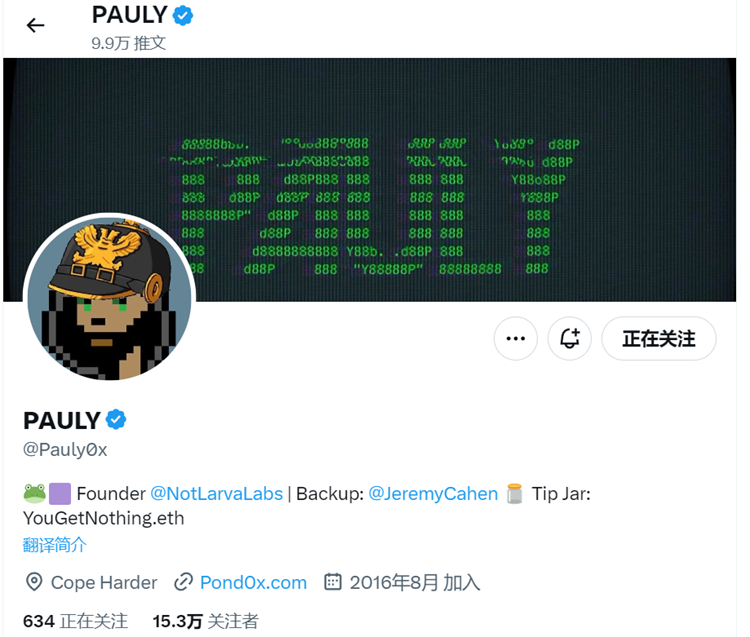
For NFT OGs, the name Pauly is well-known, if not legendary.
1. "Top Monkey Black"
Most people first became aware of Pauly during his prolonged battle with Bored Ape Yacht Club (BAYC).
At that time, BAYC was embroiled in controversy due to issues with its designs, which were accused of Nazi symbolism, white supremacy, and racial discrimination against black and Asian people.
"On June 21, YouTuber Philip Rusnack released a video accusing BAYC of using Nazi imagery and promoting white supremacy in NFT character design. He claimed that BAYC images were based on racist cartoons depicting black and Asian people, and compared the symbols and language used by Yuga Labs and BAYC to the Nazi Totenkopf emblem. Rusnack urged his audience to send their AYC holdings to a black hole address for destruction.
Mark Pitcavage, a senior researcher at the Anti-Defamation League's Center on Extremism, stated that there was no connection between BAYC's logo and Totenkopf, but agreed that some NFT features and attributes were problematic, such as the "hip-hop" feature with a gold chain and the "sushi chef headband," which perpetuated stereotypes of black and Japanese cultures.
Regardless of the outcome, the event sparked widespread discussion in Europe and the United States, leading even celebrities who had previously used BAYC NFTs as their social media avatars, such as NBA star Curry, to change their avatars."
One individual who cannot be overlooked in this event is Ryder Ripps.
Ryder Ripps was BAYC's top opponent. Since December 2021, he had been investigating BAYC and its parent company, Yuga Labs. After months of research, Ryder Ripps and other community members discovered extensive connections between BAYC and internet Nazi troll culture.
BAYC's ape images had various clothing and features, most of which Ryder Ripps believed were racially oriented or related to some type of military history.
There is a notorious historical term, "Simianization," which refers to the denigration of a racial or ethnic group by comparing its members to apes or monkeys. This behavior has a history of several hundred years, aiming to justify violence and racism against another group by comparing the target group to apes.
Simianization has been prevalent among different racial groups such as Jews, Irish, and Asians, but it primarily targeted black people. Even today, this behavior has not been eradicated, as seen in the barbaric act of throwing bananas at black football players on the field.
Ryder Ripps believed that Yuga Labs was engaging in racial discrimination against Asian and black people through BAYC, using Simianization. He also believed that the Yuga Labs team intentionally embedded Nazi dog whistles throughout the entire project, with malicious intent. He listed more than a dozen pieces of evidence to support his claims."
Pauly, a friend and supporter of Ryder, released a series of NFTs called RR/BAYC, which were specifically designed to mock BAYC. Ironically, this series briefly topped the trading volume on Opensea. Subsequently, Yuga Labs filed a lawsuit against the two, citing copyright infringement.
As for the outcome, it is currently unknown. However, even if there is a dispute over copyright, the issues with BAYC itself will eventually be addressed.
2. "CryptoPhunks" and "Not Larva Labs"
Copyright issues have always been considered one of the core issues in the NFT space. The way NFT projects grant copyright to NFT holders varies greatly, with the most common approaches being:
1) No declaration, leaving NFT holders with a vague default permission boundary; 2) Granting explicit restrictions and permissions, usually tailored to commercial and non-commercial use of the artwork; 3) Opening the artwork's copyright to the public domain, i.e., using the CC0 license.
Unfortunately, most NFT projects currently default to option 1, which goes against the principles behind Web 3.0.
One of the most controversial projects in this regard is the NFT giant, CryptoPunks.
CryptoPunks were released on June 10, 2017, by the development team Larva Labs. A snapshot of their website at the time of release showed no copyright statement.
In 2019, Larva Labs co-founder Watkinson announced in the CryptoPunks Discord channel that they would adopt an NFT license created by Dapper Labs. This NFT license allowed NFT holders to display the artwork and only use it for commercial purposes if their annual income did not exceed $100,000, but holders were not allowed to modify the artwork or use it to market third-party products.
As expected, this move sparked strong dissatisfaction and intense debate among holders. Opponents argued that this approach contradicted the vision of anti-censorship and decentralization, leading many holders to leave CryptoPunks at that time.
Therefore, at the end of 2021, a team called NotLarvaLabs released an NFT series called "CryptoPhunks," aiming to formally challenge CryptoPunks' ambiguous copyright statement. Not Larva Labs also sent an open letter to Larva Labs, claiming that they had adopted the project's IP in the name of "true decentralization" (the artwork images of CryptoPhunks NFTs were almost identical to CryptoPunks, with only the direction of the faces being reversed. PS: This seems to be Pauly's consistent approach).
"Now is the time for the NFT community to awaken. It's time to bravely face the resistance of the censorship system and make changes that go beyond the prevalent Web 2.0 system."
Our protagonist today, Pauly, is the founder of NotLarvaLabs, as stated in his Twitter bio.
3. yougetnothing.eth
In addition to NFTs, Pauly has long been involved in social experiments.
On May 30 of this year, Pauly opened an ENS address called "yougetnothing.eth" to accept Ethereum from the community, explicitly stating that no rewards would be provided. Despite this, the address raised nearly 600 ETH within a day.
Many speculated that this move was a satire of Ben.eth's fundraising activities and those who hoped to receive airdrop rewards by donating to Ben.
Although Pauly's intentions remain unknown and unverifiable, he did succeed in questioning human nature through this action.
Conclusion
Returning to the Pond0x incident itself, after learning that Pauly was the mastermind behind it, I was not surprised by the subsequent developments. After all, Pauly is someone who doesn't play by the rules.
However, I find it difficult to agree with Pauly's actions in this case. Additionally, Pauly undoubtedly bears an inescapable responsibility for the smart contract vulnerability.
But I also find it difficult to condone the behavior of ordinary investors who lose their rationality and abandon critical thinking to rush into opportunities. We all know that the crypto world is a risky and wild place, a gambling table that tests human nature.
Therefore, before entering the gambling table, understanding the rules is undoubtedly an essential self-cultivation for every "gambler."
免责声明:本文章仅代表作者个人观点,不代表本平台的立场和观点。本文章仅供信息分享,不构成对任何人的任何投资建议。用户与作者之间的任何争议,与本平台无关。如网页中刊载的文章或图片涉及侵权,请提供相关的权利证明和身份证明发送邮件到support@aicoin.com,本平台相关工作人员将会进行核查。




